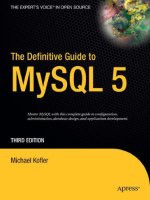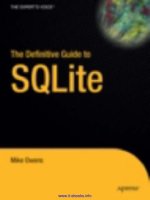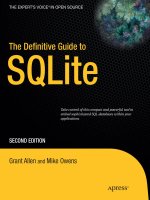Apress the definitive guide to MySQL 2nd edition oct 2003 ISBN 1590591445
Bạn đang xem bản rút gọn của tài liệu. Xem và tải ngay bản đầy đủ của tài liệu tại đây (6.35 MB, 1,279 trang )
TheDefinitiveGuidetoMySQL,Second
Edition
ISBN:1590591445
byMichaelKofler
Apress©2004(824pages)
Providesathoroughintroductiontothe
installation,configuration,implementation,
andadministrationofMySQL.
TableofContents
TheDefinitiveGuidetoMySQL,SecondEdition
Preface
PartI-Introduction
Chapter1
Chapter2
Chapter3
- WhatIsMySQL?
- TheTestEnvironment
- IntroductoryExample(AnOpinionPoll)
PartII-Fundamentals
Chapter4
Chapter5
Chapter6
Chapter7
Chapter8
Chapter9
Chapter10
- UserInterfaces
- DatabaseDesign
- AnIntroductiontoSQL
- SQLRecipes
- InnoDBTablesandTransactions
- Security
- AdministrationandServerConfiguration
PartIII-Programming
PHP—FundamentalsandProgramming
Techniques
Chapter12 - PHP—LibraryManagement
Chapter13 - PHP—DiscussionForum
Chapter11 -
Chapter14
Chapter15
Chapter16
Chapter17
- Perl
- Java,JSP,JDBC
- CandC++
- VisualBasic,C#,ODBC
PartIV-Reference
Chapter18 - SQLReference
Chapter19 - MySQLTools
Chapter20 - APIReference
PartV-Appendices
AppendixA - Glossary
AppendixB - MySQL4.1
AppendixC - ExampleFiles
AppendixD - Bibliography
Index
ListofFigures
ListofTables
BackCover
TheDefinitiveGuidetoMySQL,SecondEdition,isthe
perfectall-in-oneguidetoMySQL.Whetheryou’renew
toWebapplicationdevelopmentoryou’realreadyan
experienceddatabaseanalyst,thisbookdescribesall
ofthefacetsofMySQLconfiguration,administration,
anddatabaseapplicationdevelopment.Greatly
expandedfromitswidely-praisedfirstedition,this
updatedrevisionprovidesadditionalinformationabout
MySQLtoolssuchasMySQLControlCenterand
phpMyAdmin,databaseAPIsfromseveralpopular
programminglanguagesavailablewithLinuxand
WindowsandthelatestfeaturesfoundinMySQL4.1.
AbouttheAuthor
MichaelKoflerearnedhisPH.D.incomputerscienceat
GrazTechnicalUniversity.Hehaswrittenanumberof
successfulcomputerbooksontopicssuchasVisual
Basic,Linux,Mathematica,andMaple.Koflerisalso
theauthorofDefinitiveGuidetoExcelVBA,Second
Edition,publishedbyApress.
TheDefinitiveGuidetoMySQL,SecondEdition
MichaelKofler
TranslatedbyDavidKramer
TheDefinitiveGuidetoMySQL,SecondEditionCopyright©2004by
MichaelKofler
Allrightsreserved.Nopartofthisworkmaybereproducedortransmitted
inanyformorbyanymeans,electronicormechanical,including
photocopying,recording,orbyanyinformationstorageorretrieval
system,withoutthepriorwrittenpermissionofthecopyrightownerand
thepublisher.
ISBN(pbk):1-59059-144-5
Trademarkednamesmayappearinthisbook.Ratherthanusea
trademarksymbolwitheveryoccurrenceofatrademarkedname,weuse
thenamesonlyinaneditorialfashionandtothebenefitofthetrademark
owner,withnointentionofinfringementofthetrademark.
Translator,Editor,andCompositor:
DavidKramer
EditorialBoard:
DanAppleman
CraigBerry
GaryCornell
TonyDavis
StevenRycroft
JulianSkinner
MartinStreicher
JimSumser
KarenWatterson
GavinWray
JohnZukowski
AssistantPublisher:
GraceWong
ProductionManager:
KariBrooks
Proofreader:
ElizabethBerry
CoverDesigner:
KurtKrames
ManufacturingManager:
TomDebolski
DistributedtothebooktradeintheUnitedStatesbySpringer-VerlagNew
York,Inc.,175FifthAvenue,NewYork,NY,10010andoutsidetheUnited
StatesbySpringer-VerlagGmbH&Co.KG,Tiergartenstr.17,69112
Heidelberg,Germany
IntheUnitedStates:phone1-800-SPRINGER,email
,orvisit.OutsidetheUnitedStates:fax+496221345229,email
,orvisit.
Forinformationontranslations,pleasecontactApressdirectlyat2560
NinthStreet,Suite219,Berkeley,CA94710.Phone510-549-5930,fax
510-549-5939,email,orvisit
.
Theinformationinthisbookisdistributedonan"asis"basis,without
warranty.Althougheveryprecautionhasbeentakeninthepreparationof
thiswork,neithertheauthornorApressshallhaveanyliabilitytoany
personorentitywithrespecttoanylossordamagecausedorallegedto
becauseddirectlyorindirectlybytheinformationcontainedinthiswork.
Thesourcecodeforthisbookisavailabletoreadersat
,intheDownloadssection.Youwillneedto
answerquestionspertainingtothisbookinordertosuccessfully
downloadthecode.
AbouttheAuthor
MICHAELKOFLEREARNEDHISPH.D.incomputerscienceatGraz
TechnicalUniversity.Hehaswrittenanumberofsuccessfulcomputer
booksontopicssuchasVisualBasic,Linux,Mathematica,andMaple.
KoflerisalsotheauthorofDefinitiveGuidetoExcelVBA,Second
Edition,publishedbyApress.
AbouttheTranslator
DAVIDKRAMEREARNEDHISPH.D.inmathematicsattheUniversityof
Maryland,andhisM.A.inmusicatSmithCollege.Formanyyearshe
workedinacademia,firstasaprofessorofmathematicsandcomputer
science,andlaterasadirectorofacademiccomputing.Overthepast
eightyearshehaseditedhundredsofbooksinmathematicsandthe
sciences,andhastranslatedanumberofbooksinavarietyoffields,
includingDefinitiveGuidetoExcelVBA,byMichaelKofler;Enterprise
JavaBeans2.1,byStefanDenningerandIngoPeters;andCryptography
inCandC++,byMichaelWelschenbach,allpublishedbyApress.Other
translationsincludeTheGame'sAfoot!GameTheoryinMythand
Paradox,byAlexanderMehlmann;thechildren'smusicalRedRiding!
RedRiding!,byErnstEkkerwithmusicbySergeiDreznin;InQuestof
Tomorrow'sMedicines,byJürgenDrews;andthenovelToErrIsDivine,
byÁgotaBozai,whichwillbepublishedbyCounterpointPressinApril
2004.
Preface
MYSQLISTHEMOSTWIDELYuseddatabasesystemintheOpen
Sourcesector.Therearemanyreasonswhythisisso:
MySQLisfast.
MySQLisstable.
MySQLiseasytolearn.
MySQLrunsonpopularoperatingsystems(Windows,Linux,Mac
OSX,variousflavorsofUnix).
MySQLapplicationscanbecreatedinagreatvarietyof
programminglanguages(suchasC,C++,C#,Java,Perl,PHP,
Python,VB,andVB.NET).
MySQLisextensivelydocumentedontheInternet,andthereare
manybooksonthesubjectavailable.
MySQLisavailableformanyapplicationsfreeofcharge(GPL
license).
SincethelicensingrestrictionsofGPLareunacceptableformany
commercialapplications,therearereasonablypricedcommercial
licensesandoptionalsupportcontracts.
MySQLisonthevergeofrepeatinginthedatabasemarketthe
successachievedbyLinuxintheoperatingsystemsector.In
combinationwithPHPorPerl,MySQLisprovidingthedatabase
systemformoreandmorewebsites.(Afavoritecombinationis
Linux+Apache+MySQL+PerlorPHP.Suchsystemsarecalled
"LAMPsystems"forshort.)MySQLisnotjustforsmallwebsites;
itisusedbylargefirmswithhugeamountsofdata,suchas
Yahoo!,Slashdot,andGoogle.
WhatDoesThisBookOffer?
Thisbookprovidesacompleteapplication-andexample-oriented
introductiontothedatabasesystemMySQL.Nopreviousknowledge,
eitherofSQLordatabasedesign,isassumed.
TheintroductoryPartIofthebookbeginswithanextensiveintroduction
oninstallationunderWindowsandLinux.Wealsoconsiderthe
installationofcomponentsthatareusedincombinationwithMySQL
(Apache,PHP,phpMyAdmin,Perl,Connector/MyODBC).Buildingon
this,ourfirstexamplewillshowthebasicuseofMySQLandPHP.
PartII,"Fundamentals,"providesalargeamountofbackgroundmaterial
ontheuseofvarioususerinterfaces,onthedatabaselanguageSQL,on
theproperdesignofdatabases,ontheuseofInnoDBtables,onthe
accesssystemofMySQL,andonmanyothertopicsonadministration
(suchasbackups,logging,andreplication).
InPartIII,"Programming,"weemphasizethelanguagePHP:Three
chapterscoverbasictechniquesofprogrammingandshowhowto
constructtwoextensiveexamples(bookkeeping,adiscussionforum).
MostofthePHPexamplescanbetriedoutliveonmywebsite.Wedeal
withotherprogramminglanguages,too,withchaptersdevotedtoPerl,
Java,C/C++,andVB/VB.NET/C#.
Weendthemaintextwithareferencesection(PartIV)thatprovidesan
overviewoftheSQLcommandsofMySQL,thecommandsandoptions
oftheadministrativetools,andthefunctionsofimportantprogramming
interfaces(PHP,Perl,C,Java).
Finally,thereareseveralappendices,comprising(A)aglossaryofterms,
(B)breakingnewsontheforthcomingMySQLversion4.1,(C)information
ontheexamplefilesforthisbook(availableatwww.apress.com),and
(D)abibliographywithsuggestionsforfurtherreading.
Incombinationwiththeexampledatabasesandprograms,thisbook
shouldprovideagoodfoundationforthedevelopmentofyourown
databaseapplications.InthisIwishyoumuchfunandsuccess.
MichaelKofler,August2003
<>
/>
WhatIsNewintheSecondEdition?
Thereismuchthatisnew.Thisbookhasbeencompletelyrevised,from
thefirstpagetothelast.(Ittookaslongtoproducethissecondeditionas
towritethefirsteditionfromscratch!)Thefollowinglistindicatesthemost
importantchanges:
MySQL:ThebooknowcoversMySQL4.0andtosomeextent
MySQL4.1.Thesechangesappearthroughouttheentirebook,
frominstallationtothereferencesectiontotheappendixes.
Userinterface:Thisbookdescribesthenewuserinterface
MySQLControlCenterandthelatestversionofphpMyAdmin.
SQLrecipes:ThereisanewchapterintheintroductiononSQL
thatprovidesanswerstofrequentlyaskedSQLquestions:How
canIprocessthefirst/lastndatarecords?Howcanduplicate
recordsbelocated?HowaresubSELECTcommandsformedin
MySQL4.0and4.1?Howcanafull-textsearchbeaccomplished
efficiently?
InnoDBtables,transactions,rulesforintegrity:Anewchapter
isdevotedtotheInnoDBtableformat.InnoDBtablesenablethe
executionoftransactionswithrowlevellockingandtheprotection
oftheintegrityofrelationsbetweentables(foreignkey
constraints).
Security,accessrights:Chapter9dealswithalltheinnovations
dealingwithaccessrights(MySQLprivileges).Anewsection
givesanumberofpracticaltipsonsolvingproblemswith
establishingconnections.
Administration:Everythingrelatedtoadministrationiscontained
inasingleclearlystructuredchapter.Newsectionsdealwiththe
administrationofInnoDBtablesandservertuning(including
QueryCache).
PHP:AllPHPexampleshavebeenreworkedinPHP4.3.The
HTMLcodegeneratedfromthePHPexamplesisnowlargely
XHMTLcompatible.ThePHPtexthasbeendividedoverfour
chaptersandisnowmoreclearlystructured.InChapter11,on
techniquesofPHPprogramming,wenowalsodealwithstoring
images(fileupload/download).
Java:AnewchapterdescribesprogrammingofJavaandJSP
applicationsonthebasisofJDBCandConnector/JDBC.
C/C++:AnewchapterdiscussesthedevelopmentofCandC++
programs.
VB6:AnewexampleprogramdemonstratestheuseofBLOBs.
VB.NET,C#:AnewsectioninChapter17dealswiththe
developmentofADO.NETapplicationswiththeprogramming
languagesVB.NETandC#.
Reference:Thethreereferencechaptershavebeenthoroughly
broughtuptodateandexpandedwithnewsections(Cfunctions,
JDBCclasses).
MySQL4.1:AppendixBbringstogetherallknownchangesin
MySQL4.1:improvedcharactersetsupport(includingUnicode),
theuseofsubSELECTs,themanagementofgeometricand
geographicdata(GIS),theuseofprecompiledcommands
(preparedstatements),etc.
WhatDoesThisBookNotOffer?
SeveralchaptersinthisbookdealwiththeprogrammingofMySQL
applicationsinavarietyofprogramminglanguages,suchasPHP,Perl,
C,C++,Java,andVisualBasic.Thesechaptersassumethatthereader
isfamiliarwiththespecificprogramminglanguage.(Thereissimplyno
roominthisbooktoofferanintroductiontoanumberofprogramming
languages.)Inotherwords,youwillprofitfrom,say,thePHPchapterin
thisbookonlyifyouarealreadyfamiliarwiththeprogramminglanguage
PHP.
ExamplePrograms,SourceCode
Totheextentthatwearedealingwithwebapplications,almostallofthe
applicationsinthisbookcanbetriedoutdirectlyonmywebsite
(www.kofler.cc).Thesourcecodeforalltheexamplesisavailableat
www.apress.cominthedownloadssection.
Inthelongerprogramlistingsinthisbookyouwillfindatthebeginningof
theexampleacommentlinethatspecifiesthefilenameappearinginthe
examplefilesonthewebsite,forexample,
<!--php-programming/simpleinput.php-->
Tosavespace,sometimesonlythemostinterestingpassagesinthe
programcodeareprinted.
Versions
ThefunctionalityofMySQLandoftheprograms,programming
languages,andlibrariesplacedinitsenvironmentchangeswithevery
newversion—whichsometimesappearweekly.Thefollowingoverview
indicateswhichversionsIhaveworkedwith(explanationsofthevarious
nameswillappearatappropriateplacesinthebook):
Apache:Versions1.3.nand2.0.n.
Connector/J:Version3.0.6.
Connector/ODBC(formerlyMyODBC):Version3.51.06.
gcc:Version3.2
Java:Version1.4.1(Windows)and1.3.1(Linux).
JSP:seeTomcat.
Linux:MySQLandotherprogramsweretestedforthisbook
underLinuxandWindows.UnderLinux,thedistributionsRedHat
8.0and9.0(beta3)andSuSE8.1and8.2(beta5)wereused.
MySQL:Version4.0.14.Inmostoftheexampleprograms,
however,compatibilitywithMySQL3.23.nwastakeninto
account,sincethisversionisstillinusebymanyInternetservice
providers.Ontheotherhand,thelatestdevelopmentsofMySQL
4.1weretestedwithadevelopmentversion(alphaversion,from
endofJuly2003),asdescribedinAppendixB.
Connector/C++:Version1.7.9.
Perl:Versions5.6and5.8.
PHP:Versions4.2and4.3.Asfileidentifier,thesuffix*.phpis
generallyused.
phpMyAdmin:Version2.4.
Tomcat:Version4.0.4(JavaServlet2.2,JavaServer1.1).
VisualBasic,VBA,ADO:VisualBasicprogramswere
developedandtestedwithVB6andVBA6andADOversions2.1
and2.7.
VisualBasic.NET,C#,ADO.NET,ASP.NET:Alloftheseare
basedonVisualStudio.NET2002(.NETFramework1.0).
Windows:AlltestsunderWindowswerecarriedoutwith
Windows2000.Inprinciple,everythingshouldbevalidfor
WindowsNT4,WindowsXP,andfutureversionsofWindows.
Notation
SQLcommandsandfunctions,aswellasmethods,classes,andkey
wordsinSQL,C,Java,PHP,Perl,VB,etc.,generallyappearinitalic
(e.g.,SELECT,mysql_query).(Note,however,thatwhenthebackground
textisitalic,asinthegray"Remark,""Tip,""Caution,"and"Pointer"
boxesandsomesectionheadings,suchcommandsandfunctionswill
appearinaromanfont;e.g.,SELECT.)
Unix/Linuxusernamesalsoappearinitalic(e.g.,root,mysql).
MENUCOMMANDSUSECAPSANDSMALLCAPS(e.g.,FILE|
OPEN).
Keyboardshortcutsuseamonospacefont(e.g.,
Shift+Delete).
Fileanddirectorynamesalsousethemonospacefont(e.g.,
/usr/localorC:\Windows).
Programsandprogrammingcommandsareinthemonospace
fontaswell(e.g.,mysqlorcmd.exe).
MySQLoptionsandconfigurationparametersappearinregular
romantype(e.g.,default-charset).
Programlistingsandcommandlineinputappearinasans
seriffont.
SQLcommandsaregenerallywritteninUPPERCASEletters.Thisisnot
asyntacticnecessity,butmerelyaconvention.MySQLdoesnot
distinguishbetweenuppercaseandlowercaseininterpretingSQL
commands.
InspecifyingWindowsdirectories,wewilloftennotwriteouttheabsolute
path,sinceitdependsinanycaseontheparticularinstallation.We
observethefollowingconventions:
\Windows\meanstheWindowsdirectory(e.g.,C:\Windowsor
D:\WinNT4).
Programs\meansthedirectoryunderWindowsforprogram
installation(e.g.,C:\ProgramsorD:\ProgramFiles).
Mysql\meanstheMySQLinstallationdirectory(e.g.,C:\Mysql
orD:\ProgramFiles\Mysql).
Commands
Manycommandswillbepresentedinthisbook.Wewillbemovingback
andforthbetweentheUnix/LinuxandWindowsconventions.The
followingtwocommandsareequivalent:
root#mysqladmin-uroot-hlocalhostpasswordxxx
>mysqladmin-uroot-hlocalhostpasswordxxx
Ineachcasewehavegiventhesystemprompt(root#forUnix/Linux
and>forWindows).Youtypeinonlywhatfollowstheprompt(herein
boldfacetype).UnderUnix/Linuxitispossibletodividelonginputsover
severallines.Thelinesareseparatedbymeansofthebackslashsymbol
\.Weshalloftenusethisconventioninthisbook.Thefollowingcommand
thuscorrespondstothecommandabove:
root#mysqladmin-uroot-hlocalhost\
passwordxxx
Ineachcase,xxxistobereplacedbytherelevanttext(inthisexample
byyourpassword).Wehaveindicatedthatxxxisdummytextbytheuse
ofaslantfont.
Abbreviations
Ihaveattemptedinthisbooktomakeaslittleuseofabbreviationsas
possible.However,thereareseveralabbreviationsthatwillbeused
repeatedlywithoutbeingintroducedanewineachchapter:
ADO
ActiveDataObjects(Microsoftdatabaselibrary)
BLOB
BinaryLargeObject(binarydatablock)
GPL
GNUPublicLicense(importantlicenseforOpenSource
software)
HTML
HyperTextMarkupLanguage(formatfordescribingweb
documents)
InnoDB
Notanabbreviation,butthenameofacompanythathas
developedaspecialtableformatforMySQL(InnoDBtables)
ISP
InternetServiceProvider
JSP
JavaServerPages
MySQL
Thenameofthecompanythatdevelopedthedatabase
systemMySQL
ODBC
OpenDatabaseConnectivity(interfacefordatabaseaccess,
particularlypopularunderWindows)
PHP
PHPHypertextPreprocessor(ascriptingprogramming
languageforHTMLpages)
RPM
RedHatPacketManager(aformatforLinuxsoftware
packages)
SQL
StructuredQueryLanguage(databaseprogramming
language)
URL
UniformResourceLocator(Internetaddressoftheform
/>
VB
VisualBasic(programminglanguage)
VisualBasicforApplications(programminglanguagewithin
VBA
theMicrosoftOfficepackage)
PartI:Introduction
ChapterList
Chapter1:WhatIsMySQL?
Chapter2:TheTestEnvironment
Chapter3:IntroductoryExample(AnOpinionPoll)
Chapter1:WhatIsMySQL?
Overview
Thischapterbeginswithanoverviewofthemostimportantconcepts
fromtheworldofdatabasesandthendelvesintothepossibilitiesand
limitationsofMySQL.WhatisMySQL?Whatcanitdo,andwhatisit
unabletodo?
InadditiontodescribingthecentralfunctionsofMySQL,weshallalso
discussfullytheissueoflicensingMySQL.Whenisonepermittedtouse
MySQLwithoutpayment,andwhenisalicenserequired?
WhatIsaDatabase?
Beforewecananswerthecentralquestionofthischapter,namely,What
isMySQL?youandImustfindacommonlanguage.Therefore,this
sectionpresentsarudimentarydatabaseglossary,withoutgoinginto
greatdetail.(Ifyouhavealreadyhadsignificantdealingswithrelational
databases,youcanskipthenextcoupleofpagesingoodconscience.)
Thereisscarcelytobefoundatermthatislessprecisethandatabase.A
databasecanbealistofaddressesresidinginaspreadsheetprogram
(suchasExcel),oritcanbetheadministrationfilesofa
telecommunicationsfirminwhichseveralmillioncallsareregistered
daily,theirchargesaccuratelycalculated,monthlybillscomputed,and
warningletterssenttothosewhoareinarrears.Asimpledatabasecan
beastand-aloneoperation(residinglocallyonacomputerforasingle
user),whileothersmaybeusedsimultaneouslybythousandsofusers,
withthedataparceledoutamongseveralcomputersanddozensofhard
drives.Thesizeofadatabasecanrangefromafewkilobytesintothe
terabytes.[1]
Inordinaryusage,theword"database"isusedtorefertotheactualdata,
theresultingdatabasefiles,thedatabasesystem(suchasMySQLor
Oracle),oradatabaseclient(suchasaPHPscriptoraprogramwritten
inC++).Thustherearisesagreatpotentialforconfusionassoonastwo
peoplebegintoconverseonthesubjectofdatabases.
Relations,DatabaseSystems,Servers,andClients
Adatabaseisanorderedcollectionofdata,whichisnormallystoredin
oneormoreassociatedfiles.Thedataarestructuredastables,where
crossreferencesamongtablesarepossible.Theexistenceofsuch
relationsamongthetablesleadstothedatabasebeingcalledarelational
database.
Letusclarifymatterswithanexample.Adatabasemightconsistofa
tablewithdataonafirm'scustomers(name,address,etc.),atablewith
dataontheproductsthefirmoffers,andfinally,atablecontainingthe









